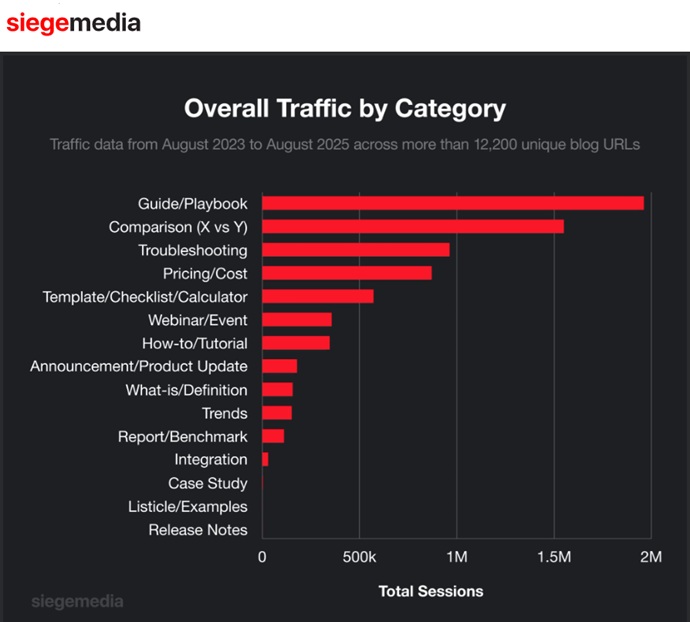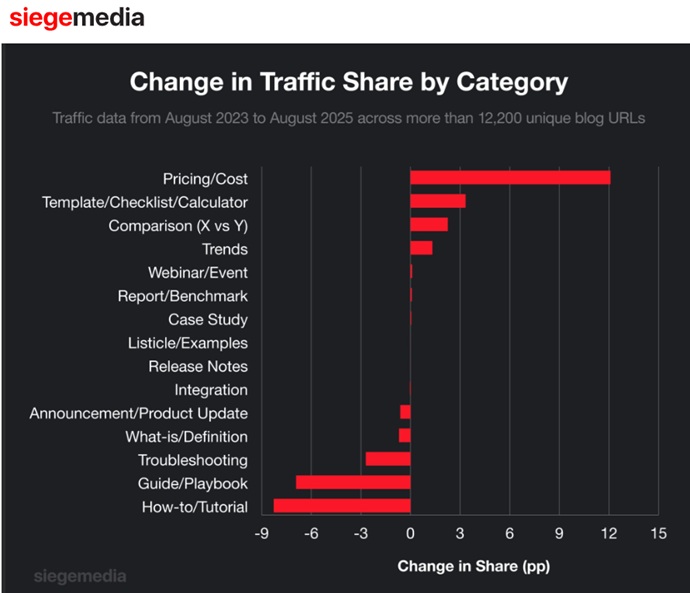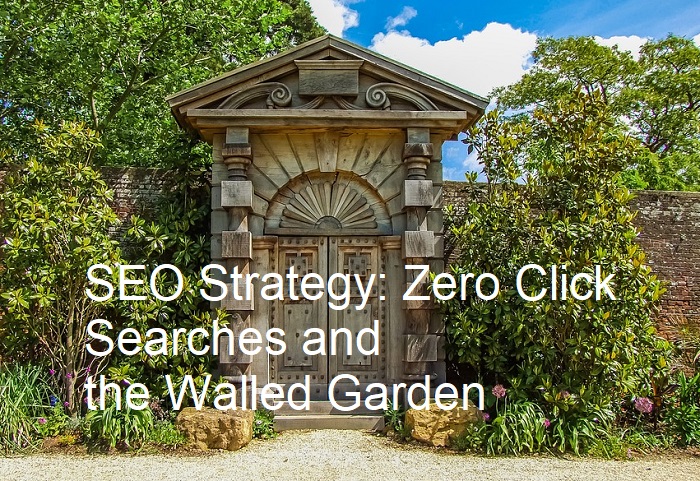The Immediate Impact of Trend Style Content
An interesting new report just published by Seige Media tells us a lot about the trends in content today. It relates to how fresh, relevant and immediately useful our content is. And in how we might use trending topics/info to raise search engine rankings, gain pre-eminence with visitors, and improve visitor engagement.
The world of AI search engines and newsy, current topics and information is fused and we must keep up to it. Have a quick look at your web stats and you’ll see how visitors bounce off of content that isn’t a trendy topic, specifically relevant nor fresh. The “trend” is a complex value consumers are fixated on to help guide their purchase choices.
And consumers arriving at our website are deeper into their search, and we need to meet them at their actual specific interests including their price ranges. Most consumers have price points or limits in mind as they search. So if your SEO results and visitor engagement are trending down, it’s likely you’re not paying attention to price or features that are shaping their behavior on the search engines.
AI Search Engines Short Circuit the Shopper Experience
AI LLM search engines, increasingly in favor by consumers (including Google’s AI search mode) are answering basic queries on their sites, thus creating what’s called the zero-click user experience. Whether low or good quality, these search engines are providing answers to general type queries and spending more time on those engines. So they don’t need your generic content anymore and they’re not referring as many visitors to you.
It’s only when questions get more specific and they need to cite current circumstances that they’ll conduct more research and include links to websites that contain high-quality and trending content. This is what GEO optimization is for.
Seige’s report entitled Content Type Popularity and Engagement Trends [New Data] by Michael Arhambault found a clear, accelerating shift toward bottom-of-funnel (BOFU) content that could be the result of AI search.
Key takeaways from the Seige Media Report:
- Pricing-style content has grown significantly in engagement value
- Comparison style content rose slightly
- Top of funnel general content topics such as how-to and guide pieces are declining in engagement.
As general material is used less, it seems overall content engagement is rising, which suggests the MOFU and BOFU content is more relevant and valuable to them. They’re deeper into their search quest, which means they’re closer to a decision and less likely to bounce off your site (if your conversion funnel is working).
This trending style factor will also affect your PPC advertising and social media content choices as well. It’s part of a greater emphasis on personalization and immediate, in-the-moment relevance.
These two graphics below from Seige Media’s report contained in the report, show a change in what visitors are interested in. If it’s trending upward, it reflects a new view of what’s important to them. Something we need to take seriously.


Trending Content’s Significance
Trend-style content is important to small business owners. Customers want to ensure they’re buying products and services that will have lasting value. Few want to buy products, services or apps they know will be obsolete or incompatible with mainstream usage.
“Trend-style content” refers to content that taps into what’s changing now — emerging behaviors, technologies, consumer shifts, or market movements. For content strategists, it’s all about forecasting or interpreting momentum, not just reporting facts. This is where EEAT factors become essential as you drill down to create the right value for your readers.
In this post, we take a deeper look at trending topics to become a little more clinical and strategic about creating trending content to stay current to AI search engines and consumer interest. We’ve always created trending topics of course (i.e., news stories, events, industry developments, etc.) yet we need to understand this matter more clearly, so we serve up content strategically for AI LLM search engines and for Google and Bing.
So, this is all about what’s called trend style content, and how we’ll develop it for maximum impact and relevance to AI search engines. Because GEO is here and we need to be on top of it.
What Is Trend-Style Content?
“Trend-style content” refers to content that taps into what’s changing now — emerging behaviors, technologies, consumer shifts, or market movements. It’s about forecasting or interpreting momentum, not just reporting facts.
Trend content typically falls into one or more of these formats:
| Type | Example Headline | Purpose |
| Industry Trend Reports | “Top Travel Consumer Trends for 2025” | Establish authority and drive backlinks |
| Data/Insight Pieces | “Search Demand for ‘Solo Travel’ Is Up 63% — Here’s Why” | Show expertise backed by data |
| Pattern + Prediction Content | “Why All-Inclusive Resorts Are Making a Comeback in 2025” | Position you as forward thinker |
| Trend vs Trend Comparison | “Remote Work Is Fueling Long-Stay Tourism — Here’s the Proof” | Highlight emerging connections |
| Quarterly/Annual Roundups | “2025 Marketing Trends That CMOs Can’t Ignore” | Good for recurring content |
Why Does Trend Content Perform Well Now?
- High Shareability — People like to post what feels “new” or “ahead of the curve” to be of more value to their connections
- Great for LinkedIn & PR — People gossip about the latest news and these raise our thought leadership reputation when they share.
- Backlink Magnet — Journalists and bloggers cite trends when building narratives for their content.
- Top-of-Funnel Attention Grabber — Perfect for attracting audiences before they even know they need you and moving them faster into your MOFU or BOFU content.
Key Macro Trends Shaping MOFU / BOFU Content Today
| Trend | What’s Changing / Why It Matters | Implications for MOFU / BOFU Content |
| AI & Generative Search (AI-first discovery) | Search and discovery are increasingly mediated via AI systems (ChatGPT, Gemini, etc.). Users may get answers in “AI overviews” or “instant answers” without clicking. Exposure Ninja+2Eleven Writing+2 | Your MOFU/BOFU content must be structured, well-signaled (headings, lists, examples, schema), and authoritative enough to be cited by AI summaries. Also, include original insights, case studies, experience. |
| Zero-click & “answer engine” risk | More queries are answered directly on SERPs, via AI, or via featured snippets, reducing click-throughs. Exposure Ninja+2MGID+2 | You can no longer rely solely on “get them to click your page.” Part of your BOFU content must win in those answer boxes. And your MOFU content should help feed into those answer boxes and build trust so when they click, your brand is top of mind. |
| “Doing more with less” efficiency pressure | Marketers are stretched; content teams have to deliver higher ROI with fewer resources. | You’ll want content that can be modular, repurposed, updated, or progressively enhanced rather than “one-shot” flagship pieces. Also lean on tools/automation for draft, repackaging, and measurement. |
| Hyper-personalization & dynamic content | Audiences expect content aligned to their context (industry, use case, pain points). Broad generic content is less effective. | BOFU content should dynamically address segments (e.g. “for large enterprises,” “for SMBs,” “for first-time buyers”). MOFU content should use persona-aware framing—“If you’re X, here’s what matters.” |
| Mixed-media & interactivity as table stakes | Static long-form content alone is less adequate. Video, tools, calculators, quizzes, interactive demos are expected. | MOFU/BOFU content should embed interactive elements—ROI calculators, side-by-side feature comparison matrices, configurators, interactive case studies, decision trees, even short videos or product walkthroughs. |
| Content audits and decay prioritization | A lot of legacy MOFU/BOFU content underperforms. Content teams are pruning or refreshing to boost ROI. | Prioritize optimizing existing consideration/decision pieces instead of always creating new ones. Update stats, improve CTAs, re-optimize for SEO/AI, repurpose into new formats. |
| Thought leadership + original insight anchoring trust | Because AI can generate generic content, what differentiates is original experience, data, insider knowledge, experiments. | Your MOFU/BOFU content should not be a rehash. Inject unique case studies, proprietary benchmarks, interviews, internal data, comparative frameworks that can’t be replicated easily. |
| Ecosystem / partnership content & co-creation | Brands are collaborating more (guest content, joint content, co-marketing) to reach new audiences and increase credibility. | For BOFU especially, consider content with third parties (e.g. analysts, tools providers, complementary products) to show integrated value. |
| Shorter attention spans + chunked structure | Even decision content needs to be scannable, with clear signals, visual aids, micro-summaries. | Format MOFU/BOFU content with executive summaries, TL;DRs, bullet paths, “key takeaways,” FAQ sections, visual decision matrices. Complement with short video capsules that preview/expand. |
Best Types / Topics of MOFU / BOFU Content to Prioritize (High Leverage)
Here are the content types and topic areas that tend to outperform when designed well for mid-to-bottom funnel roles:
| Content Type | What It Does / Why It Works | Good Examples / Variants | Tips & Pitfalls |
| Comparison / Alternatives Pages | Helps buyers evaluate you vs competitors or substitute solutions | “YourProduct vs Competitor A vs DIY” | Use clean feature grids, honest pros/cons. Beware of making it anecdotal—show data, real user feedback. |
| Solution / Use-Case Deep Dives | Show how your solution fits in a specific context | “How X works in [industry/vertical]”, “Use-case of migrating from legacy system” | Include visuals, process flows, edge cases, decision criteria. Tie to real outcomes. |
| ROI / Value Calculators & TCO Workbooks | Quantifies the value of your product/service for readers | “Calculate your 3-year ROI with us”, “Total cost of ownership vs alternate path” | Show both conservative and aggressive outcomes; allow user inputs for legitimacy. |
| Customer Stories / Case Studies (Detailed, outcome-focused) | Acts as social proof with narrative, context, impact | “How Customer A saved $X by switching”, “Before & after with metrics” | Don’t just describe—tie to problem, decisions, and results. Use visual data (charts, timelines). |
| Free Trials / Demos / POCs + Guided Walkthroughs | Pushes people toward hands-on experience | “Schedule your demo”, “Interactive sandbox + guided tour” | Seamless onboarding and nudging are crucial. Make it low-friction. |
| Implementation Guides / Playbooks | Helps prospective buyers imagine success and plan transition | “Step-by-step implementation for new users”, “Onboarding checklist” | Use checklists, timelines, pitfalls, tips. Helps reduce anxiety about switching. |
| Feature Launch / Module Explainers | Focuses on a new or key feature that differentiates | “What’s new in version 2.0 – here’s why it matters” | Emphasize benefits, use cases, and context rather than just specs. |
| FAQ / Objection-Handling Content | Addresses last-minute doubts proactively | “Will this integrate with X?”, “What about data security?”, “Hidden costs?” | Put these near or on BOFU pages; surface them in MOFU content too. |
| Guarantees / Risk-Reduction Content | Emphasizes safety: warranties, return policies, price locks, proof | “Satisfaction guarantee”, “No hidden fees”, “Money-back terms” | Be transparent and legally solid. Don’t overpromise. |
| Interactive Tools / Simulators / Diagnostic quizzes | Engages and helps them self-assess | “Which plan fits you?” quiz, “Risk score simulator”, “Readiness check” | Follow up with personalized content or offers based on results. |
| Video Walkthroughs / Demos | Lowers friction — many prefer visual explanation | Short explainer clips, feature tour videos, recorded case studies | Keep them tight (2–5 min), highlight “so what,” add captions. Host transcripts for SEO/AI. |
Strategic Tactics & Considerations to Boost Impact
To get the most out of MOFU / BOFU content, here are strategic moves to layer in:
| Trend Style Tactic | Why It Helps | How to Implement |
| Progressive Disclosure / Multi-tier Content | Don’t overwhelm. Let users “drill down” | On a comparison page, begin with summary grid, then expand into sections with “Learn More” links to deeper content. |
| Signal Content Intent Early | Helps users self-select and skip what they don’t need | Use labels like “For Enterprise,” “For SMB,” “Detailed Tech Version,” “Executive Summary.” |
| Cross-linking Paths (TOFU → MOFU → BOFU) | Keeps people in your content funnel | When someone reads a TOFU post, show “Next step” links to relevant MOFU content. MOFU pages should link to BOFU offers. |
| Dynamic Content Variants / Smart Content | Serve content aligned with visitor type or behavior | Show different headlines, CTAs, or sections depending on referral source, industry, or known attributes. |
| Strong Calls-to-Action (CTAs) with Micro-Commitments | At MOFU/BOFU, you want to reduce friction | Instead of “Contact us,” use “Get a custom quote,” “See it in action,” “Try 7 days free.” Use multiple CTAs (primary / secondary). |
| Trust Signals & Third-Party Validation | Helps tilt uncertain buyers | Embed logos, awards, certifications, media mentions, and especially real quotes with names/pics. |
| A/B Test Offers & Message Framing | Even small shifts in framing or CTA text can increase conversion | Test “Book Demo” vs “See It Live,” “Download TCO Guide” vs “Calculate Your ROI,” etc. |
| Update & Refresh Regularly | Prevent content decay, keep it current and competitive | Revisit BOFU comparators, adopter stories, ROI calculators every 6–12 months and update data. |
| Rewrite / Repurpose Into Different Formats | Reach different consumption preferences | A deep case study → summary infographic, video clip, short audio highlight, Slideshare deck, social snippets. |
| Track & Optimize for Intent + Behavior | Use data to see which pieces are really working to move people down the funnel | Track assisted conversions (which MOFU pages led into BOFU actions), time to conversion, drop-offs, click paths. Optimize based on that. |
| Incorporate Sales or Product Expertise | Leverage insights from sales / support teams to shape content | They know what objections buyers raise and what language resonates. Use those objections/questions directly in FAQ pages, objections content, etc. |
| Guarantees & Risk-Reducing Messaging Early | Reduces hesitation closer to purchase | In BOFU and even MOFU content, include guarantee statements, “you can always cancel,” SLAs, etc. |
What’s Shifting / What Might Change Soon
- AI-driven “content-as-decision-assistant” — The next wave will see more intelligent content that adapts in real time to user input (e.g. dynamic pages that evolve based on prior answers in the session).
- Greater convergence between content and product — Especially in SaaS, content modules might appear inside the app or UI (help content = marketing content).
- Short-form video even in BOFU — As video becomes essential for nearly every funnel stage, we may see 30–60 second videos summarizing ROI, demo snippets, feature callouts embedded even on decision pages.
- More direct AI Chatbot integration with content — Imagine content pages where the user can “ask a question” and get tailored clarifications or content paths immediately.
- Hybrid human + AI attribution / co-creation models — Teams will likely use AI to create skeletons, research / assemble data, but humans will always need to add voice, insight, differentiation (because generic AI-based content won’t persuade at BOFU).
Deeper Dive into Price-Based Content
Price-Based Content could be becoming the dominant BOFU style. Price issues are current and always a trend. Due to the quickened discovery and preliminary research on AI search engines, buyers are deeper into their decision-making process.
Pricing content signals relevance, transparency, and trust. When done well, it generates top significance for your company as you prove they are getting the best value for the price points they have in their minds. With confidence built, you may be able to upsell them too. Because while price appears to be the issue, it’s often more a matter of perceived value they want. Avoiding price-related responses is a point of non-transparency which undermines confidence in your offer/brand as they do their research.
Types of Price-Based Content Performing Best Today
| Content Type | Why It Works | Example Format |
| Transparent Pricing Pages / Tier Tables | Supports direct purchase decisions | “Pricing & Packages” / “Standard vs Premium vs Enterprise” |
| Cost Guide Articles | Captures high-intent SEO & reduces sales friction | “How Much Does It Cost to Move Across the Country in 2025?” |
| Budget-Based Recommendation Content | Helps users self-select | “Best Moving Package If You’re Under $2,500 Budget” |
| Price Comparison Content | Helps buyers rationalize their decision | “DIY vs Full-Service Movers: Cost Breakdown with Scenarios” |
| ROI & Payback Period Calculators | Justifies price through logic | “Calculate Your Savings Over 12 Months Switching to X” |
| “What’s Included” / “No Hidden Fees” Content | Tackles distrust caused by surprise fees | “What’s Actually Covered in Our Quote (and What’s Not)” |
Why Price-Based Content Converts Better Than Generic Benefits Content
It’s better because:
- It answers the real question buyers have before purchase: “Will this be worth it?”
- It reframes cost as investment + value instead of expense
- It reduces anxiety around risk, hidden fees, or bait-and-switch pricing
- It attracts backlinks from journalists, bloggers, and aggregator sites who cite price benchmarks
- It filters out poor-fit leads (saves your sales team time)
And because most companies avoid explicit pricing content, those who lean into transparency dominate rankings AND trust acquisition.
That’s our look at the best of trend content. Whether you’re in travel, real estate, manufacturing, professional services or app development, being current makes your company and brand more relevant to the point of being “number one significant.”
Hopefully, this guide on trend style content will help give you that lift you need to get the edge in search engines and customer engagement.
Contact me regarding fresh, trend-style content to raise your rankings, AI search visibility and visitor engagement.
Title image courtesy of Stockcake.







